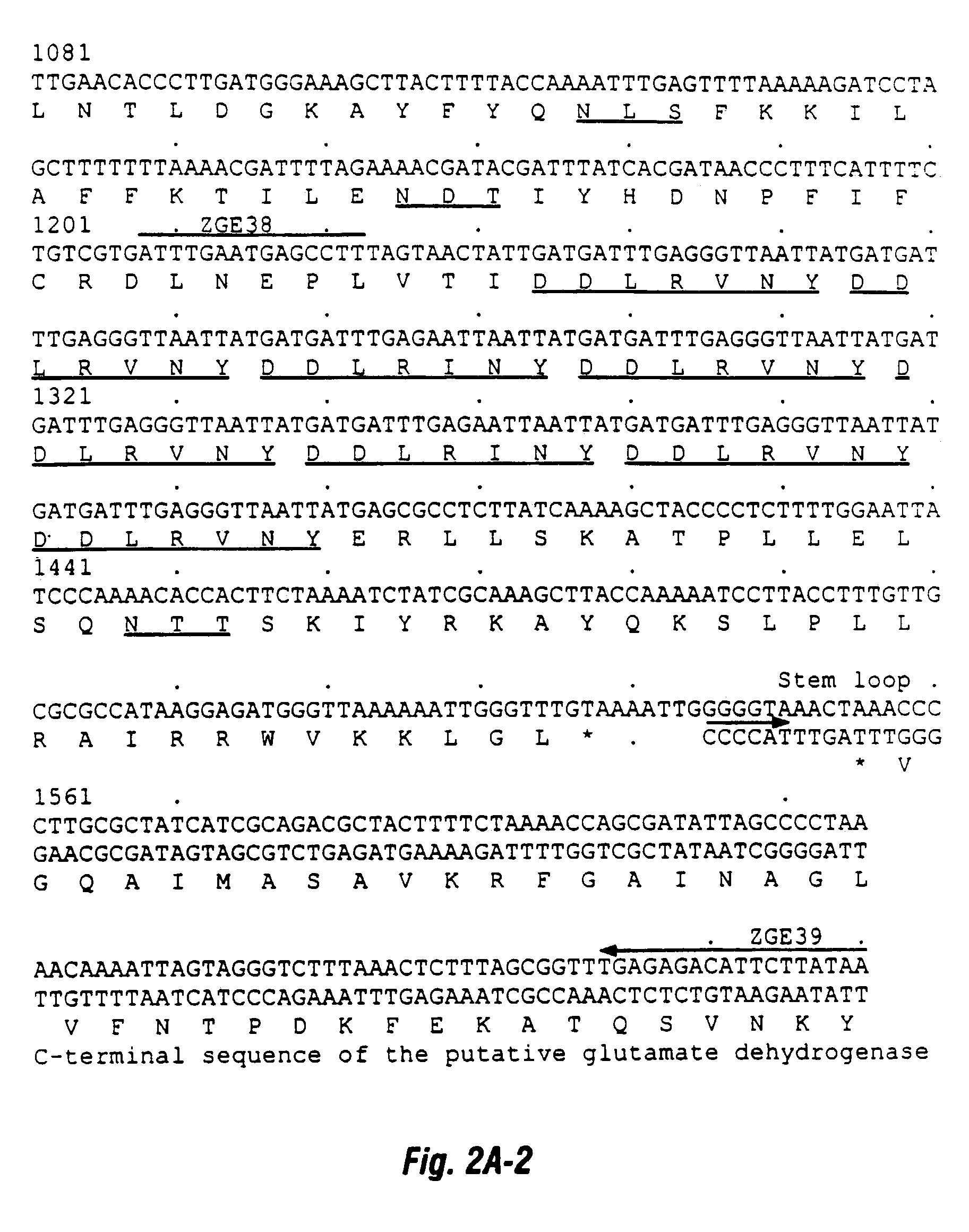Α1,3-fucosyltransferase
a technology of fucosyltransferase and polypeptide, which is applied in the field of fucosyltransferase, can solve the problems of low yield, complex procedures, and synthesis of these products, and achieves the effects of low yield, high yield, and high efficiency
- Summary
- Abstract
- Description
- Claims
- Application Information
AI Technical Summary
Benefits of technology
Problems solved by technology
Method used
Image
Examples
example 1
[0101]Cloning of the H. pylori fucosyltransferase (fucT) gene To clone the fucosyltransferase gene from H. pylori NCTC11639, degenerate primers were generated from the several regions conserved by three mammalian α1–3 fucosyltransferases, including human FucT VI, bovine FucT III and mouse FucT VI. Primer FUTF3 (5′TT[T / C]TA[TC]CT[T / C / A / G]GC[G / A / T / C]TT[T / C]GA[A / G]AA3′) (SEQ ID NO: 23) corresponds to residues 242–248 of human FucT VI, whereas primer FUCTR2 (5′AA[A / G]TC[A / G]TC[G / ATC]AC[A / G]TG[G / A / T / C]AG[A / G]AA3′) (SEQ ID NO: 24) is complementary to the sequence deduced from its residues 289–295. An expected DNA fragment of ˜170 nt was PCR-amplified from chromosomal DNA of H. pylori NCTC11639 with the primer pair of FUCTF3 and FUCTR2 under a thermocycling program of 40 cycles: for the first two cycles, 1 min at 94° C., 30 sec at 40° C. and 40 sec at 72° C.; for the remaining cycles, 1 min, at 94° C., 30 sec at 50° C. and 40 sec at 72° C., followed by extension at 72° C. for 10 min. The P...
example 2
[0103]Plasmid constructs and Expression of the H. pylori fucT gene To construct recombinant plasmids containing an intact or partial H. pylori fucT gene, three primers were generated from the nucleotide sequence in FIG. 2A: ZGE37 corresponding to nucleotides 1–19 (SEQ ID NO:28); ZGE38 (SEQ ID NO:29) and ZGE39 (SEQ ID NO:30) complementary to nucleotides 1215–1233 and 1660–1679 respectively. ZGE37 contained a BamHI site, whereas ZGE38 and ZGE39 contained an EcoRI site. PCR products were amplified from pBKHpfucT3 1 with a primer pair of either ZGE37 / ZGE38 or ZGE37 / ZGE39. These PCR-amplifled DNA fragments were digested with EcoRI and BamHI, and then cloned into pBluescript II KS-(Stratagene, La Jolla, CAS). The respective clones containing the H pylori fucT gene of interest were screened by PCR with the corresponding pair of the above primers. Two clones, designated pBKIHp763funcT38 and pBKiHp763fucT39, contained a partial and an intact H pylori fucT gene respectively. The coding region...
example 3
Fucosyltransferase Assays
[0104]E. coli CSRDE3 cells expressing nonradioactively labeled proteins encoded by pBKHp763fucT38 and pBKHp763fucT39 were harvested and suspended in Hepes buffer (20 mM Hepes, pH 7.0) supplemented with 0.5 mM of phenylmethylsulfonic fluoride (a proteinase inhibitor). Subsequently, membrane and soluble fractions of the cells were prepared after disruption with a French press. The membrane pellets were resuspended in the same Hepes buffer, frozen in liquid nitrogen, and stored at −70° C. until use.
[0105]Assays of H. pylori α1,3 and α1,4 fucosyltransferase activities were conducted at 37° C. for 20 min in a volume of 20 μl containing either 720 μM LacNAc-R for α1,3-fucosyltransferase activity, Galβ1-3GlcNAc-R for α1,4-fucosyltransferase activity, or 5.33 mM Phenyl-Gal for α1,2-fucosyltransferase activity, 50 μM GDP-fucose, 100,000 d.p.m GDP-[3H]fucose, 20 mM Hepes buffer (pH 7.0), 20 mM MnCl2, 0.2% BSA and 8.5 μl of the enzyme fraction. The incubation mixtures ...
PUM
| Property | Measurement | Unit |
|---|---|---|
| temperatures | aaaaa | aaaaa |
| pH | aaaaa | aaaaa |
| temperatures | aaaaa | aaaaa |
Abstract
Description
Claims
Application Information
 Login to View More
Login to View More - R&D
- Intellectual Property
- Life Sciences
- Materials
- Tech Scout
- Unparalleled Data Quality
- Higher Quality Content
- 60% Fewer Hallucinations
Browse by: Latest US Patents, China's latest patents, Technical Efficacy Thesaurus, Application Domain, Technology Topic, Popular Technical Reports.
© 2025 PatSnap. All rights reserved.Legal|Privacy policy|Modern Slavery Act Transparency Statement|Sitemap|About US| Contact US: help@patsnap.com



